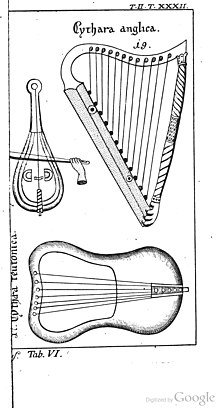List of European medieval musical instruments
Appearance
This article needs additional citations for verification. (February 2017) |
This is a list of medieval musical instruments used in European music during the Medieval period.
| Part of a series on |
| Medieval music |
|---|
| Overview |
|
|
Percussion
[edit]| Names and variations | Description | Ethnic connections, regions | Pictures | Pictures |
|---|---|---|---|---|
| Adufe[1] | A frame drum brought to Iberia by Muslims and played mainly by women.[2] Used in the charamba in Portugal, a circle dance for couples.[2]
The adufe is a square or rectangular frame drum usually made of pine, over which is mounted a goat's skin. The size of the frame usually ranges from 12 to 22 inches on each side, and 1 to 2 inches thick. The skin is stitched on the sides, with the stitches covered by a coloured ribbon. In the interior small seeds or small stones are placed to make pleasing sounds. |
Iberia
Porugul Spain |
 | |
| Bumbulum (legendary) | ||||
| Clappers
cliquettes |
Clappers from the Carolingian Empire appear to have been disks or possibly chimes attached to sticks. Other versions were blocks of wood held in the palms. The palm-held blocks could make clicking and rattle noises like castanets. Other similar instruments worldwide include the Thai/Cambodian krap sepha, Indian/Nepali khartal, Uzbek/Tajik qairaq, or North African krakebs. |   |
  | |
| Cymbals |  |
 | ||
| *Frame drum | ||||
| Jew's harp[3] | ||||
| Nakers |  | |||
| Pandeiro[4] | ||||
| Tabor
Pipe and tabor |
 | |||
| Tof | Tof was the Hebrew instrument which Miriam played, "most commonly translated" into English as timbrel[6] Near eastern origin, used by Gauls, Greeks, Romans (tympanum), Egyptians, Assyrians. [7] Jingles were probably originally separate from this instrument.[7] Also related to Daff.[7] |  |
 | |
| Triangle |  |
String instruments
[edit]- Citole[8][9]
- Cretan lyra
- Dulcimer
- Fiddle
- Gittern[9]
- Guitarra latina
- Guitarra morisca[10]
- Medieval harp (Medieval form of the modern harp)
- Hurdy-gurdy
- Lute[11]
- Lyre
- Organistrum (large form of medieval hurdy-gurdy)
- Psaltery
- Rebab
- Rebec[12]
- Tromba marina
- Vielle
- Viol[13]
- Zither

Wind instruments
[edit]- Bagpipes[14]
- Bellows pipe
- Bladder pipe
- Bombard
- Buisine
- Crumhorn
- Flageolet
- Flute
- Gemshorn
- Organ
- Portative Organ
- Recorder
- Sackbut[15]
- Shawm[16]
- Tabor Pipe
- Zampogna
References
[edit]- ^ Gutwirth, Eleazar (1998). "Music, Identity and the Inquisition in Fifteenth-Century Spain". Early Music History. 17: 161–181. ISSN 0261-1279.
- ^ a b Schechter, John M. (1984). "Adulfe". In Sadie, Stanley (ed.). The New Grove Dictionary of Musical Instruments. Vol. 1. p. 25.
- ^ The Jew's harp : a comprehensive anthology. Leonard Fox. Lewisburg: Bucknell University Press. 1988. ISBN 0-8387-5116-4. OCLC 16356799.
{{cite book}}: CS1 maint: others (link) - ^ Mauricio Molina (2006). Frame Drums in the Medieval Iberian Peninsula. pp. 101–. ISBN 978-0-542-85095-0. Retrieved 25 December 2012.
- ^ "TIMBREL - JewishEncyclopedia.com". Jewishencyclopedia.com. Retrieved 2016-05-13.
- ^ Sadie, Stanley, ed. (1984). "Timbrel". The New Grove Dictionary of Musical Instruments. Vol. 3. p. 585.
- ^ a b c Sadie, Stanley, ed. (1984). "Tambourine". The New Grove Dictionary of Musical Instruments. Vol. 3. p. 511.
- ^ [1] [dead link]
- ^ a b Baker, Paul. "The Gittern and Citole". Retrieved 4 December 2016.
- ^ Galpin, Francis William (1911). Old English Instruments of Music. Chicago: A. C. McClurg and Company. pp. 21–22.
- ^ "A Panoply of Instruments for Medieval, Renaissance, and Baroque Music". Music Educators Journal. 65 (9): 38–69. 1979. doi:10.2307/3395616. ISSN 0027-4321.
- ^ Spohnheimer. "The Rebec". Music.iastate.edu. Archived from the original on 2016-05-04. Retrieved 2016-05-13.
- ^ "About the Viol". Archived from the original on 2015-02-03. Retrieved 2014-12-08.
- ^ Jones, G. Fenwick (1949). "Wittenwiler's "Becki" and the Medieval Bagpipe". The Journal of English and Germanic Philology. 48 (2): 209–228. ISSN 0363-6941.
- ^ Spohnheimer. "The Sacbut". Music.iastate.edu. Archived from the original on 2016-05-04. Retrieved 2016-05-13.
- ^ Spohnheimer. "The Renaissance Shawm". Music.iastate.edu. Archived from the original on 2016-05-25. Retrieved 2016-05-13.
External links
[edit]This list of songs or music-related items is incomplete; you can help by adding missing items. (October 2021) |




